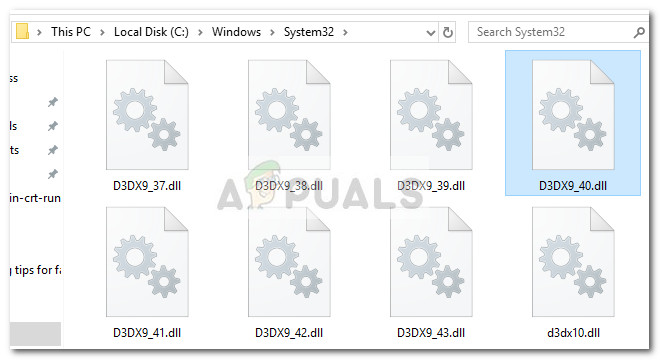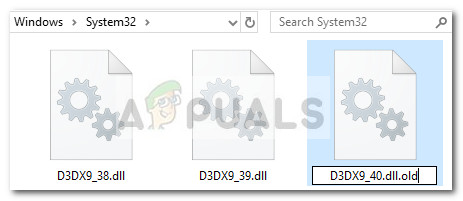After cycling to most occurrences that affected users have reported, we concluded that there are two types of error messages associated with the d3dx9_40.dll file:
The program can’t start because d3dx9_40.dll is missing from your computer. Try reinstalling the program to fix this problem.C:\Windows\system32\d3dx9_40.dll is either not designed to run on Windows or it contains an error. Try installing the program again using the original installation media or contact your system administrator or the software vendor for support.
Although the two error messages look different, the root cause is often times the same. The vast majority of these errors will occur because the application in question cannot call the d3dx9_40.dll file. This is either because it’s missing from your system or because it’s corrupted. Most of the time, errors related to the d3dx9_40.dll file are reported in when the user tries to open an older game that uses optional DLL files included in the DirectX 9 distribution.
What is d3dx9_40.dll?
The d3dx9_40.dll file is just a small part of the many DLL files contained in the Microsoft DirectX software distribution packages. Each DLL (Dynamic Link Library) file contains a specific functionality that other 3rd party programs can call upon. This allows multiple programs to share functionalities that are rooted in a single file. Keep in mind that the d3dx9_40.dll file is part of an optional DirectX 9 update that is not present by default on Windows 8 or Windows 10 (neither does it install via Windows Update). Warning: Downloading an individual d3dx9_40.dll file from a DLL download site is not advised. Often times, users that took this shortcut found that so-called quick fix actually ended up producing a different error message. Even more, security researchers argue that some of those DLL files that are hosted individually might actually contain malicious code that is designed to leave your system exposed to future virus infections. The best way to resolve an issue of this kind is to only follow those methods that stick to the official channels (such as the ones below).
How to fix errors associated with d3dx9_40.dll
If you’re looking for a viable fix for an error associated with d3dx9_40.dll, start troubleshooting with the methods below. Both methods included below are confirmed to work by users that managed to solve the issue after finding themselves in a similar situation. Please follow the two potential fixes in order until you come upon a method that manages to fix the problem.
Method 1: Installing DirectX End-User Runtimes
Most users that have struggled with an error associated with the d3dx9_40.dll file have managed to promptly address the issue by installing the DirectX End-User Runtimes. Unless your system is suffering from underlying corruption, the steps below should resolve any issue caused by the d3dx9_40.dll file: If you’re still struggling with the same issue, move down to Method 2.
Method 2: Deleting or Renaming the corrupted d3dx9_40.dll
If the first method hasn’t fixed your problem, there’s a strong chance that some corruption is preventing the d3dx9_40.dll file from being replaced with a fresh copy. Luckily, some users facing the same issue discovered a fairly easy workaround. This method involves deleting the actively used d3dx9_40.dll file from all locations that Windows uses to call upon it. If the corrupted file refuses to be deleted, we’ll rename the DLL file using the .old executable – essentially telling Windows to treat it as an outdated version. Here’s a quick guide (with screenshots) of removing all the actively used d3dx9_40.dll occurrences and then reinstalling the DirectX redist:
Fix: d3dx9_38.dll is missing or not designed to run on WindowsFix: D3D11.dll is not designed to Run on WindowsFIX: “(Application Name).exe – Bad Image” is either not designed to run on…Fix: SDL.dll is missing or SDL.dll not found



